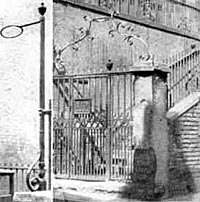< Previous | Contents | Next >
Old lamp holders, St. Mary's churchyard
 |
THESE two wrought-iron lamp holders are all that is left to us of the street lighting of ancient Nottingham. A great globe of thick glass was fixed in each of the iron circles, and this glass was filled with whale oil upon which floated a wick, which, when lighted, did something to illuminate the darkness of bygone Nottingham.
The story of public lighting in Nottingham is not without interest. The earliest record of any attempt at street lighting in England occurs in Charles I.’s reign, when a patent was granted to hang out a lantern in front of every twelfth house in London.
But Nottingham was not quite so up-to-date as this, and remained in gloom until 1762, the year in which Wedgwood established his potteries. in that year the Corporation of Nottingham took powers for public lighting and festooned the streets, at somewhat rare intervals, with lamps and lamp holders similar to those remaining on the palings of St. Mary’s Churchyard.
These two lamp holders, however, were not erected at that time. As a matter of fact, the palings round St. Mary’s Church were only set up in 1807 (the year in which the slave trade was abolished), and we may assume that these lamp holders date from that time.
The supply of whale oil for the town was kept in casks under the steps leading up to the old Guild Hall in Weekday Cross, and the smell from this stock must have rendered the neighbourhood somewhat unpleasant.
Just before the Battle of Waterloo, that is to say, in 1814, gas was first introduced into Nottingham as a public illuminant. The gas works were set up at the bottom of Hollow Stone, and it was found that ten lamps were quite sufficient to illuminate the whole town!
One was set up at the top of Hollow Stone, another at the top of Drury Hill, five in Bridlesmith Gate, and three in front of the Exchange.
When they were first lighted, folk flocked from far and near to witness the wonder of a flame burning without a wick.
